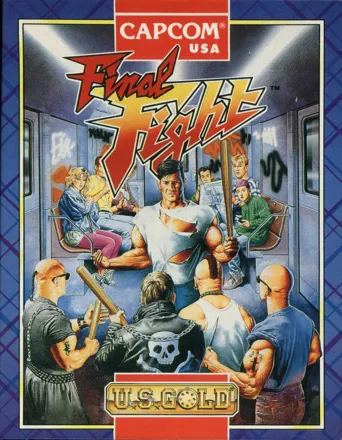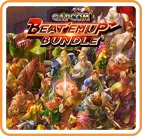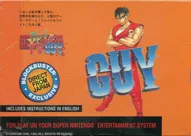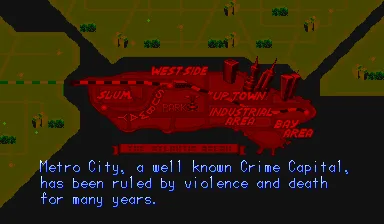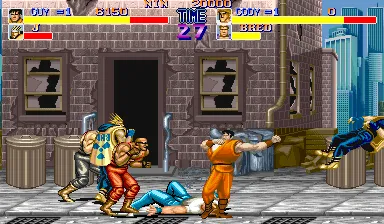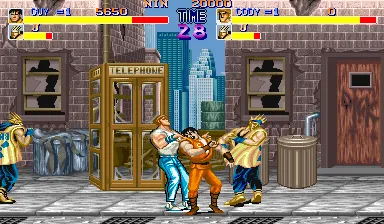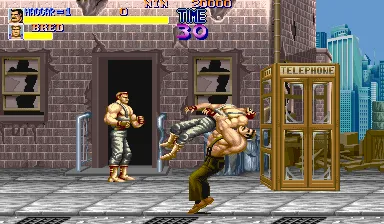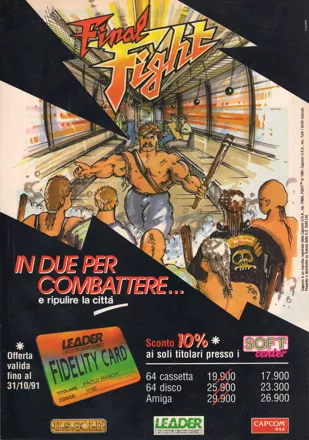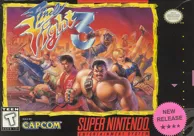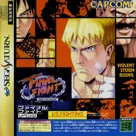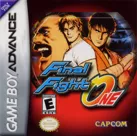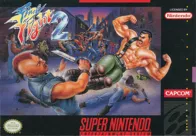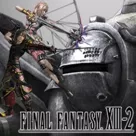Final Fight
Description official description
The streets of Metro City are filled with criminals who are part of a gang called Mad Gear. Former wrestler and newly elected mayor Mike Haggar tries to do something about it, much to the displeasure of the Mad Gear Gang who kidnap his daughter Jessica. Only three people are brave enough to venture into the crime-infested streets and try to bring Jessica back.
Final Fight is a 2D side-scrolling fighting game. Taking on the role of either Cody, Guy, or the mayor Mike Haggar himself, you must advance through six areas of the city clearing out the gang infestation. You will have to cope with a variety of thugs, ranging from firebomb-throwing maniacs to behemoth wrestlers. To defeat these thugs, you have an arsenal of punches, kicks, throws, and jump kicks at your disposal.
The Sega CD port adds voice acting to the game's intro and ending cutscenes and also adds a time attack mode (beat up as many enemies as possible in a limited amount of time). This version can only display four enemies on screen at once. The C64 version can only display two enemies on screen at once. Then the SNES version is different enough to warrant its own entry.
Spellings
- ファイナルファイト - Japanese spelling
Groups +
Screenshots
Promos
Videos
Add Trailer or Gameplay Video +1 point
See any errors or missing info for this game?
You can submit a correction, contribute trivia, add to a game group, add a related site or alternate title.
Credits (Arcade version)
25 People (21 developers, 4 thanks)
| Planner |
|
| Programmer |
|
| Hard |
|
| Character Design (Object) |
|
| Character Design (Scroll) |
|
| Music / Sound |
|
| Special Thanks |
|
Reviews
Critics
Average score: 72% (based on 44 ratings)
Players
Average score: 3.8 out of 5 (based on 128 ratings with 5 reviews)
Manages to be both better and worse then the other 16bit ports of the game
The Good
Final Fight is a classic arcade game in the beat 'em up genre.
It is not terrible complicated story and, it certainly doesn't waste time with ethics or philosophy. It is just you (and a friend) wandering through several urban locations, circa 1989, in order to beat the you-know-what out a dangerous criminals.
Simple? Yes, but still a heck of a lot of fun to play, especially if you are old enough to remember when the premiered at your local video arcade.
Several efforts were made to port the arcade game to the home console systems throughout the 1990s. In some ways the Sega CD edition is the best of the bunch.
Final Fight CD features all of the arcade's playable characters, and allows up to two people to place at the same time. Other cartridge editions of Final Fight had to eliminate some of the playable characters and only allowed for one player.
Final Fight CD also features some cool music, as well as the all of the arcade levels and bonus rounds. It is nice to see such some of the Sega CD's hardware potential being used.
The Bad
Final Fight CD does take a noticeable hit in the graphics department, as the designers had to work with the Sega CD's embarrassingly weak on-screen color and pallet capacities.
Like the Sega Genesis, the "Next Level" Sega CD hardware was limited to 64 colors on screen out of a pallet of 512. This was at a time in the industry, when must computers and even most cartridge and CD-ROM based game systems had better capabilities.
What does this mean for this game?
Basically, Final Fight CD cannot be a perfect port in terms of the graphics, and, arguably, has trouble matching the SNES (capable of 256 colors on screen from a pallet of over 32,000) of Final Fight in this respect.
Sega allowed the Sega CD port of Final Fight to retain the female (technicaly, they are transsexuals) enemies from the original arcade games, albeit with less provocative clothing. Although certain character names (I.e. "Sodom") were still modified.
Frankly, the censorship seems a bit silly, although I can appreciate why such changes were made, especially when this was before the ERSB was created in to rate games (in the U.S. and Canada) for possibly offensive, objectionable or questionable content.
I suppose the biggest complaint, aside from the censorship or hardware limitations, is that the genre that Final Fight helped to build, had since moved on.
None of the playable characters have nearly as many possible offensive and defensive moves as, say Streets Of Rage 2.
The Bottom Line
Final Fight CD is a solid port of the arcade game, with all of the playable characters, bonus leaves and ability to play the game without th a friend. It shows its age, as well as the hardware foilables of the Sega CD, but fans of beat 'em ups will still want to give this one a spin.
SEGA CD · by Edward TJ Brown (118) · 2014
Better than Final Fight on the SNES. Worse than Streets of Rage 2.
The Good
Final Fight CD is was the best version of Final Fight to hit the home console market until 2005 when it came out for the Playstation 2. It has many features missing from the Super Nintendo translation such as the missing level, the female characters, and the missing playable character, Guy.
There are some extra features and graphics not found in any other version of Final Fight such as additional into screens. There are also three timed levels with new backgrounds that are not found in the Arcade. I would rather they had incorporated them into the main part of the game as extra levels than making them selectable demos, however.
It is better than Final Fight for the SNES, better than Streets of Rage for the Genesis, and better than Final Fight 3. It is inferior to Streets of Rage 2 and about on par with Final Fight 2.
This was the best fighting game for the Sega CD and was among the main reasons many purchased the Sega CD system (which had few merits).
The Bad
The color pallet on this game is tremendously reduced from the arcade game, making the graphics inferior to its SNES counterpart.
This is not excusable because Sega's own Streets of Rage 2 had far more colorful graphics than Final Fight CD. Final Fight CD has all of the muscle of the Sega CD's extra processor and extra storage capacity leading one to believe that the only reason it could possibly have such a washed out color pallet is due to lazy programmers.
The music tracks are silly. I would rather have had a duplication to the Arcade game than the silly jazz tracks they put on this CD. The voices are also campy and poorly acted.
The game is has worse play control than the arcade resulting in difficult situations in which it is impossible not to get killed (in later stages).
The Bottom Line
This is arguably the best version of Final Fight to come to home systems prior to the Capcom Classics Collection for the PS2. It has some extra features seen in no other version of Final Fight making it worthwhile for collectors. I'd recommend the PS2 version over this one, however.
If you like this game I would also recommend the following: Streets of Rage 2 (Genesis) Final Fight 2 (SNES) Captain Commando (SNES) Capcom Classics Collection (PS2) *Streets of Rage (Genesis)
SEGA CD · by Majestic Lizard (670) · 2014
The Good
Final Fight cd is often praised for it's good music, extra introduction screens and being close to the arcade conversion. The introduction has spoken dialogues and extra animated screens that aren't in the arcade. The game has also a time attack mode where the object is to defeat as many baddies as you can. This mode has some new locations that fit the game very well.
The Bad
This "good" music are just plain audio tracks, and what is so special about that? Anyone can just record real music and put it on a disc. The audio tracks just fade out and start over and that can be real ugly to listen to especially in the real long levels like the bay area. The game is still heavily censored: there is no blood, roxy and poison's clothes are larger, the liquor is still absent, the thug that discovers his car in a bad condition still says: "oh my car" etc.
Most of the stuff is still missing, from the beginning you can tell those barrels are deleted and so it happens many times during play. This is just an incomplete arcade version.
The graphics may be close to the real final fight, it's colours are definitely not. Maybe the sega cd couldn't do any better, but I cannot bear to see these washed out colours any longer.
There is something wrong with the animation and the hit detection. For some reason I can't explain it simply does not play the same as the arcade version.
And finally my real complaint about this conversion: The introduction with spoken words is real nice but why didn't they hire real voice actors?? Haggar doesn't sound like a mighty wrestler but like a wimp! The voice of the villain also sounds like a goof. I am not very happy about that, it is a major disappointment as it just doesn't fit the gorgeous animated introduction.
The Bottom Line
If you want to enjoy the arcade game to it's full glory you still have to stick with the real arcade game. However, if you are a real final fight fan like me, I do recommend you to watch the enhanced intro and to try out the time attack mode.
SEGA CD · by Schutzstaffel88 (12) · 2014
Trivia
1001 Video Games
The Arcade version of Final Fight appears in the book 1001 Video Games You Must Play Before You Die by General Editor Tony Mott.
Amiga port theme music
Jolyon Myers' theme music from the game's Amiga port is an original composition of his called Lost In Time, originally made for the 1990 Amiga demo/musicdisk Amazing Tunes II, which also had other tunes by Myers under his scene name The Judge (Final Fight credits him under that name rather than with his real name). While the actual compositions and samples are identical between both versions, the version used on Final Fight plays slightly faster than the original Amazing Tunes II version.
Amiga startup-sequence code reference
Amiga version programmer Richard Aplin included a humorous piece of text in that version's startup sequence, in which he dismisses the accomplishment of Ronald Pieket Weeserik's Dynamic Loading System, used in SWIV to load the game as it played without losing any speed. Aplin argues that others had written the same code trick before, but found it too unwieldy to justify its use in most circumstances - though it was on show in Final Fight.
Development
Capcom firstly designed Final Fight to be the sequel to Street Fighter named Street Fighter '89, but they changed their minds and decided to give the game a new name and start a new series. Akira Nishitani said in Retro Gamer 37:
"Our intention was to develop Final Fight" as an original game in its own right - and that's what we did. However, "Street Fighter" had such a high name value, we decided to make use of its recognition and changed the name to "Street Fighter'89" fof a game show where it was displayed. At the game show it received an excellent reception, proving even more popular than we could have hoped. But this really wasn't related to "Street Fighter". We'd made "Final Fight" as we'd intended - with a totally different and new world view, so once its popularity had been confirmed, we decided to go back to the original name."
Sales
According to publisher Capcom, Final Fight has sold 1.48 million copies worldwide since its initial release (as of June 30, 2016).
Version differences
- All home computer versions of Final Fight include a shot of the Mayor's daughter tied up in her underwear during the opening sequence, which was only seen in Japanese arcades (it was censored in Europe and America).
- The female gang members (Poison/Roxy, etc.) haven't had much luck appearing in the home ports of the game. All the Nintendo versions replaced them completely with male enemies (this includes the GBA remake, at least the US version) and while they appear in some rare ports they can only be found with edited clothing. Only the rare Japanese SEGA CD version shows them in their original form.
- In contrast to the SNES version of Final Fight, the U.S. version of Final Fight CD had less differences to the original Japanese version: the girl punks were given slightly longer clothes, blood was taken out, Jessica wears her red dress in the intro (she was stripped to her underwear in the arcade and Japanese versions), DamnD's name was changed to Thrasher, Sodom's name was changed to Katana, the "SEXY" graffiti from the restroom stalls in one level was removed, and the references to beer and whisky were removed.
Wrestling connection
The enemy Andore bears resemblance to a wrestler called Andre the Giant however Akira Nishitani in Retro Gamer 37 stated that he had a friend whose nickname was "Andre" and it was actually him who the characters in "Final Fight" were named after. Though, Akira also admitted that those characters do look like Andre The Giant.
The story of Mike Haggar also has a parallel with the story of former wrestler Jesse Ventura, who left the ring to become governor in Minnesota.
Easter eggs
Japanese version of the game is filled with many Easter eggs.
- When you smashed up a bucket and a drum, if you could hit the right button at the right time the items change into lump of gold or a diamond that are worth 10000 points each.
- On level 3 Edi.E - the boss spits out the gum. It is possible to pick it up. When your character has full energy, it gives you 42910 points which is the date of birth of Akira Nishitani (42nd year of Showa Era (1967), September 10th).
- If you complete the last level on one coin, you can see a special ending which in Japan was called the "gyudon" (translated means "beef bowl").
Bonus stages
There were many different ideas for the bonus stages. It was planned to have a crash bonus rounds like destroying a piano and a house as well as beating bad guys until they were buried in the ground up to their shoulders. Eventually all these ideas (some of them were even developed) were cut out.
Awards
- Commodore Format
- July 1993 (Issue 34) - Modern Classics: Beat-'em-ups (It's a Croaker!)
- November 1994 (Issue 50) – #2 & #5 The Bottom 10
Information also contributed by Alexander Michel, Cantillon, Depth Lord, Johnny "ThunderPeel2001" Walker, Perfil Falso, and Zovni.
Analytics
Upgrade to MobyPro to view research rankings and price history! (when applicable)
Identifiers +
Contribute
Are you familiar with this game? Help document and preserve this entry in video game history! If your contribution is approved, you will earn points and be credited as a contributor.
Contributors to this Entry
Game added by NeoMoose.
Arcade added by 666gonzo666. iPhone added by Sciere. ZX Spectrum added by Martin Smith. J2ME added by Deleted. SEGA CD added by Satoshi Kunsai. Sharp X68000 added by Terok Nor. Amstrad CPC, Commodore 64 added by Katakis | カタキス. Atari ST, Amiga added by The Ring Hawk.
Additional contributors: Terok Nor, Satoshi Kunsai, chirinea, Alaka, Martin Smith, Lance Boyle, Caelestis, CalaisianMindthief, Patrick Bregger, mailmanppa, FatherJack.
Game added October 4, 2001. Last modified January 15, 2025.


